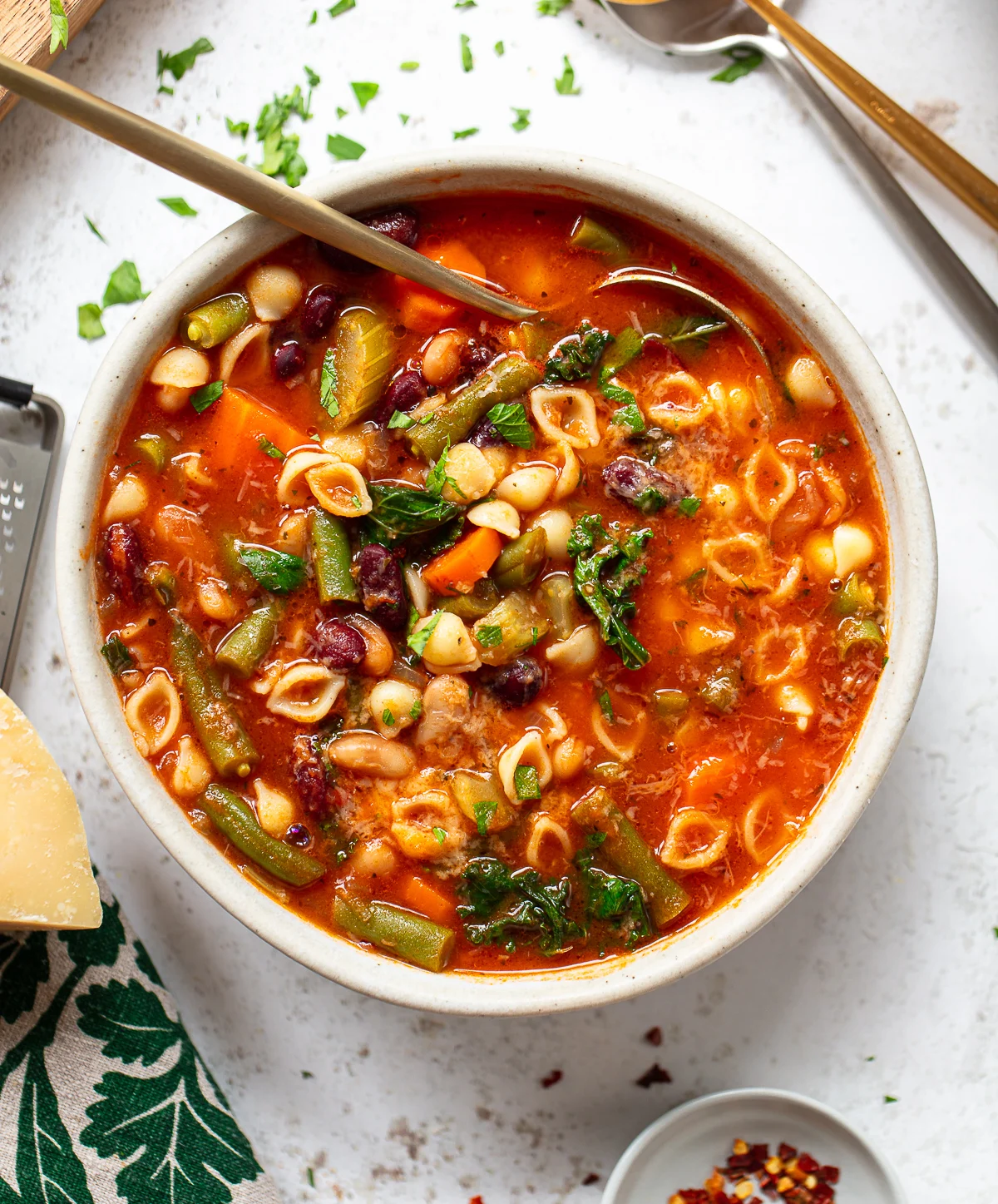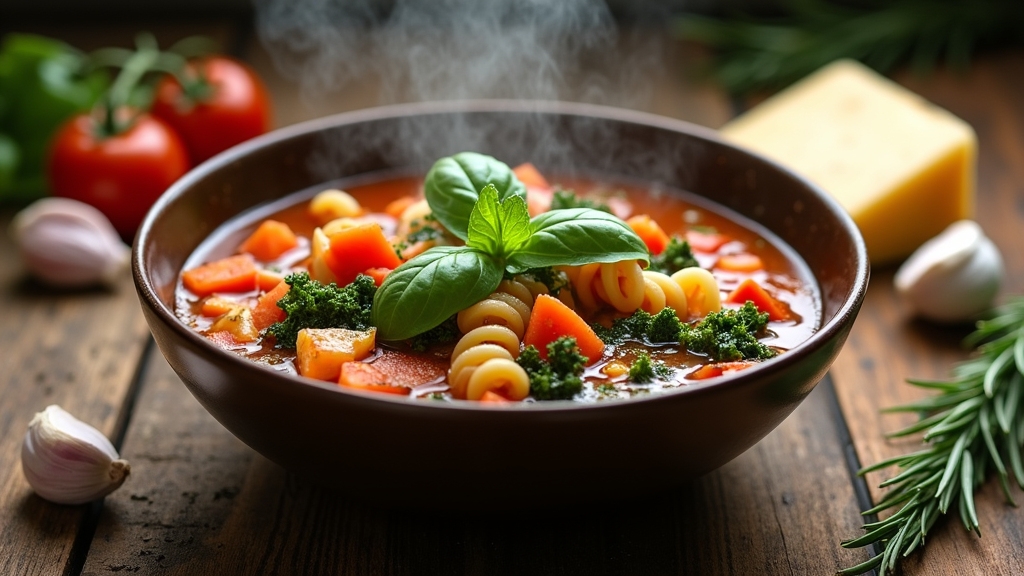If you’re looking to make a comforting Italian minestrone soup, I’ve got you covered! Start by sautéing chopped onions, carrots, and celery in olive oil for a fragrant base. Then, add vegetables, cannellini beans, your choice of pasta, and vegetable broth. Simmer until everything’s tender and flavors meld beautifully. This versatile dish showcases fresh produce and can be customized to your liking. Stick around, and I’ll share how to amp up the flavors and nutritional benefits!
History
When I think about the history of minestrone soup, I can’t help but feel a connection to its rich Italian roots. This beloved dish dates back to ancient times, evolving from humble beginnings as a peasant meal. Its Italian origins are steeped in tradition, with each region proudly showcasing its unique take. For instance, northern Italy often embraces creamy textures and hearty vegetables, while the south leans towards a lighter, tomato-based broth. I love how minestrone reflects the local produce available, making every bowl a celebration of regional variations. This adaptability not only speaks to its cultural significance but also invites innovation, allowing chefs to experiment with flavors while honoring the soup’s storied past.
Recipe
Ministroni soup is a hearty and versatile Italian dish that is perfect for any season. Bursting with fresh vegetables, beans, and pasta, this soup not only warms the soul but also nourishes the body. The beauty of ministroni lies in its adaptability; you can easily customize it with whatever vegetables or grains you have on hand, making it a great way to use up leftover ingredients. This comforting bowl of goodness can be enjoyed as a main course or a side dish, and it pairs wonderfully with crusty bread.
To create a delicious ministroni soup, you’ll want to focus on fresh, high-quality ingredients. Begin by gathering your vegetables and herbs, which will infuse the soup with vibrant flavors. The base of the soup typically includes onions, carrots, and celery, but feel free to add seasonal vegetables like zucchini or spinach. The key to a rich and satisfying broth is allowing the flavors to meld together over time, so don’t rush the cooking process. With a bit of patience and the right ingredients, you’ll be rewarded with a bowl of nourishing soup that is sure to please everyone at the table.
Focusing on fresh ingredients enhances the vibrant flavors of ministroni, creating a nourishing soup that delights everyone at the table.
Ingredients:
- 2 tablespoons olive oil
- 1 onion, chopped
- 2 carrots, diced
- 2 celery stalks, diced
- 3 cloves garlic, minced
- 1 zucchini, diced
- 1 cup green beans, chopped
- 1 can (14 oz) diced tomatoes
- 4 cups vegetable broth
- 1 can (15 oz) cannellini beans, drained and rinsed
- 1 cup small pasta (like ditalini or elbow)
- 1 teaspoon dried oregano
- 1 teaspoon dried basil
- Salt and pepper to taste
- Fresh parsley, chopped (for garnish)
In a large pot, heat the olive oil over medium heat. Add the chopped onion, carrots, and celery, and sauté until the vegetables are tender, about 5-7 minutes. Stir in the garlic, zucchini, green beans, diced tomatoes, vegetable broth, cannellini beans, oregano, and basil. Bring the mixture to a boil, then reduce the heat and let it simmer for about 20 minutes. Add the pasta and cook for an additional 10-12 minutes, or until the pasta is al dente. Season with salt and pepper to taste, and garnish with fresh parsley before serving.
When making ministroni soup, remember that the longer it simmers, the more flavorful it will be, so don’t rush the process! You can also customize the soup by adding different vegetables or proteins such as cooked chicken or sausage. If you prefer a thicker consistency, puree a portion of the soup and mix it back in. This soup also freezes well, making it a perfect make-ahead meal for busy days. Enjoy your ministroni soup with a sprinkle of Parmesan cheese for an extra touch of flavor!
Cooking Steps
Now that we have our ingredients ready, let’s jump into the fun part: cooking! I’ll guide you through each step, from chopping those fresh vegetables to letting everything simmer together for that perfect flavor. Trust me, the aroma as it cooks will have your mouth watering in no time!
Step 1. Chop Fresh Vegetables Finely
As I gather my fresh vegetables for the ministroni soup, I focus on chopping them finely to enhance their flavors and guarantee they meld beautifully in the broth. Using precise knife techniques, I start with onions, dicing them into tiny pieces that will release their sweetness as they cook. Next, I tackle carrots and celery, ensuring uniformity in size to promote even cooking. I love the rhythm of chopping—the crunch of the knife against the cutting board and the vibrant colors of the vegetables. Each piece plays a vital role in the overall dish, so I take my time, savoring the process of vegetable preparation. The finely chopped veggies will create a rich, harmonious base for my soup.
Step 2. Add Broth and Seasonings
Once the vegetables are finely chopped and ready, I pour in six cups of rich vegetable broth, allowing it to envelop the aromatic mixture. For this soup, I love experimenting with different broth types—sometimes I use a savory mushroom broth for depth, and other times, a classic vegetable broth for a lighter touch. Next, I reach for my favorite seasoning blends. A sprinkle of Italian herbs, a dash of red pepper flakes, and fresh cracked pepper elevate the flavor profile. The aroma swirls around me, creating an inviting atmosphere. I make sure to taste as I go, adjusting the seasonings to my liking. This balance of broth and seasonings sets the foundation for a delightful ministroni experience.
Step 3. Simmer Until Vegetables Tender
With the broth and seasonings perfectly blended, I bring the pot to a gentle simmer. This is where the magic happens! Using effective simmering techniques, I let the vegetables cook slowly, allowing their natural flavors to meld beautifully. I keep a close eye on the pot, stirring occasionally to guarantee even cooking. As the minutes pass, I can almost taste the anticipation of that perfect vegetable tenderness. Carrots, zucchini, and green beans gradually soften, transforming into vibrant, flavorful bites that will elevate the soup. I usually aim for about 20-30 minutes; this gives the veggies enough time to become tender yet still retain some of their structure. Trust me, this step is vital for that hearty, wholesome experience!
Step 4. Add Pasta or Rice
After the vegetables have reached that perfect level of tenderness, it’s time to add the pasta or rice, turning this soup into a hearty meal. I love experimenting with different pasta variations—small shells or ditalini can add a delightful texture, while whole grain options pack in extra nutrients. If I’m in the mood for something a bit different, I’ll often reach for rice alternatives like quinoa or farro, which lend a nutty flavor and a satisfying chew. Just toss in your choice, adjusting the cooking time to guarantee everything melds beautifully. As the pasta or rice cooks, the broth thickens, and the flavors deepen, creating a comforting bowl of goodness that warms both body and soul.
Step 5. Stir in Fresh Herbs
As the soup simmers and the aroma fills the kitchen, I can’t resist the urge to stir in fresh herbs, which elevate the flavors to a whole new level. I love adding a handful of chopped basil and parsley right before serving; their vibrant colors and aromas are simply irresistible. Fresh herbs not only enhance the taste but also pack a nutritional punch, offering antioxidant benefits and boosting immunity. To keep my herbs fresh longer, I store them in a glass of water in the fridge, covering them with a plastic bag. This helps maintain their vitality and flavor. Remember, adding herbs at the end preserves their essence, ensuring every spoonful bursts with freshness. Enjoy the transformation!
Nutritional Guide
While I appreciate a hearty bowl of minestrone soup for its comforting taste, it’s also important to contemplate its nutritional benefits. This soup is not only delicious but also packed with essential nutrients that can invigorate my body. Here’s a quick glance at its calorie count and nutritional highlights:
| Nutritional Benefit | Amount per Serving |
|---|---|
| Calories | 150 |
| Fiber | 6g |
| Protein | 7g |
With a variety of vegetables and legumes, minestrone soup offers vitamins A and C, antioxidants, and heart-healthy fibers. Its low-calorie count makes it a perfect choice for anyone looking to maintain a balanced diet while enjoying innovative flavors. So, you can indulge guilt-free!
Final Thoughts
Even if I savor the rich flavors of minestrone soup, I also appreciate how it embodies the essence of comfort food while delivering essential nutrients. This dish invites creativity, allowing me to experiment with ingredient variations like adding different beans, seasonal vegetables, or even grains for added texture. One of my favorite cooking tips is to sauté the vegetables first; it enhances their flavors beautifully. Don’t shy away from herbs and spices—thyme, basil, or a hint of chili can elevate your soup to new heights. Whether you’re making a traditional version or putting your own twist on it, minestrone is a canvas for culinary innovation. I hope you enjoy making this versatile dish as much as I do!
Frequently Asked Questions
Can I Use Canned Vegetables for Ministroni Soup?
Absolutely, I’ve used canned vegetables in soups before! They’re convenient and save time, but I’ve noticed they can lack freshness and flavor. Balancing their benefits and drawbacks can lead to a satisfying dish.
What Is the Best Type of Pasta for This Recipe?
When I think about pasta types for my favorite soup, I always reach for ditalini. Its small size cooks quickly, soaking up flavors beautifully. Plus, it adds a delightful texture that elevates every spoonful.
How Can I Make Ministroni Soup Vegetarian?
To make a delicious vegetarian soup, I use vegetable broth options and add flavorful vegetarian substitutions like beans, zucchini, and kale. These ingredients create a hearty, satisfying meal that’s both innovative and comforting. Enjoy the flavors!
Can I Freeze Leftover Ministroni Soup?
Did you know that over 60% of people love freezing leftovers? I’ve found that using airtight storage containers with proper freezing tips keeps my soups fresh for months, making later meals a breeze to enjoy!
What Wine Pairs Well With Ministroni Soup?
When I think about wine pairings, I love a crisp Sauvignon Blanc. Its bright acidity complements the hearty flavors of the soup beautifully, enhancing the dish’s flavor profiles and creating a delightful dining experience.
Conclusion
As I ladle the steaming ministroni soup into bowls, the aroma of fresh herbs and simmering vegetables wafts through the air, igniting my senses. Each spoonful reveals a burst of flavor, a comforting embrace on a chilly evening. Just when I think I’ve savored every nuance, there’s a delightful surprise of sweetness from the hidden carrots. This isn’t just a meal; it’s an invitation to gather around the table, sharing stories and laughter, as the warmth envelops us all.

Ministroni Soup Recipe Italian
Ingredients
Equipment
Method
- Heat olive oil in a large pot over medium heat.
- Add onion, carrots, and celery. Sauté for 5 minutes until softened.
- Stir in garlic and cook for 1 minute until fragrant.
- Add zucchini, green beans, and potatoes. Cook for 3 minutes.
- Pour in diced tomatoes and vegetable broth. Bring to a boil.
- Reduce heat to low, cover, and simmer for 20 minutes.
- Stir in cannellini beans and pasta. Cook for 8-10 minutes until pasta is tender.
- Add spinach/kale and Italian seasoning. Cook for 2 minutes until wilted.
- Season with salt and pepper to taste.
- Ladle into bowls and garnish with Parmesan and fresh basil (if using).
- Serve with crusty bread.

